JEO 7 - The HTV-X Cargo Freighter and the LEO Supply Chain
A monthly news roundup plus a deep dive on the JAXA HTV-X cargo vessel and its future roles.
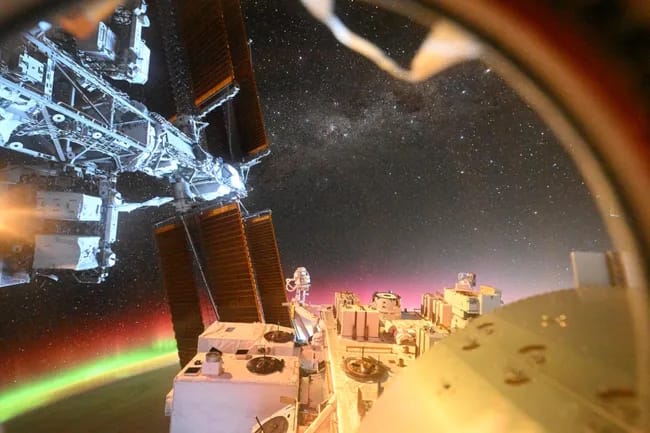
Welcome to Japan Earth Observer (JEO), a free (approximately) monthly newsletter with a news roundup and one in-depth article about the space, Earth observation and geospatial industries in Japan. In addition to a news roundup, in this edition I’m also going to write a bit about the new HTV-X cargo supply spacecraft JAXA just launched for the first time to the ISS.
News & Announcements
💱 Contracts and Funding
-
Astroscale and Open Cosmos have been awarded a US $7 million three-year contract with the UK Ministry of Defense []SpaceNews] to support design, manufacturing, launch, and operation of the two Orpheus satellites. The two satellites will fly in close formation with a hyperspectral imager and four other instruments for studying the ionosphere and the impacts of space weather caused by solar activity.
-
Interstellar Technologies has raised JPY 8.9 billion (~US $62 million) for work on a launch vehicle and satellite technologies and represents a mix of new capital from investors and debt financing. Interstellar is considering this latest round as a Series F, and will continue to provide capital for development of its Zero launch vehicle as well as communications satellites. Currently, the vehicle is expected to launch in 2027 from the Hokkaido Spaceport in Taiki.
-
Space BD, a launch services provider, and Gilmour Space, an Australian launch vehicle developer, have signed an agreement enabling Space BD to sell space on Gilmour’s Eris small launch vehicle.
- Why does this matter? Gilmour’s southern hemisphere spaceport will enable SpaceBD to be able to offer more launch options to its customers as well as deliver payloads and components for the ElaraSat bus that Gilmour has also developed.
-
Mitsubishi Heavy Industries has signed a contract with Sierra Space to provide another Passive Common Berthing Mechanism (PCBM) for docking pressurized spacecraft at the ISS.
- Why does this matter? The HTV-X cargo supply vehicle does not yet have an autonomous docking capability, so until it does MHI is buying PCBMs from Sierra.
-
ASTRO GATE and SpaceShift signed an MOU to work together on solutions that use satellite data for spaceport development. ASTRO GATE plans, develops, and operates spaceports, not just as places from which to launch rockets but also as catalysts for regional economic development. To promote private-sector use of satellite data, SpaceShift operates the SateBiz Consortium, of which ASTRO GATE will become a member.
-
Geolonia has acquired Georepublic Japan. Georepublic has been a long-time contributor to open data and open source geospatial software tooling with significant experience developing government technology. Geolonia is a developer of web mapping, addressing, and smart city tools.
- Why does this matter? The Georepublic acquisition adds a significant bench of open source software engineers as well as the founder, Seki Haruyuki, to the team. Seki is a bit of a technology celebrity in the govtech world. In addition to Georepublic, he has led Code for Japan and HackCamp as well as serving as Chief Digital Service Fellow for Tokyo Metropolitan Government and Chief Innovation Officer for Kobe City and as an advisor to a range of government entities..
-
Interstellar has secured three additional investors, Sumitomo Mitsui Bank, SPARX Asset Management, and Japanet. The additional funds include JPY 6.5 billion (US $45.1 million) in equity financing and JPY 2.4 billion ( US $16.7 million) in debt financing. This is Sumitomo Mitsui’s first space-related investment, and the bank will also contribute expertise to help build and strengthen the manufacturing supply chain. Interstellar has additional funding from the Japanese government through a Phase 3 SBIR from the Ministry of Education, Culture, Sports, Science, and Technology (MEXT) and the JAXA Space Strategy Fund.
-
SkyPerfect JSAT and iQPS have been awarded a contract to provide SAR imagery by the Japan Ministry of Defense (JMoD). The contract only runs through March 31, 2026, though, so I’m guessing that this is a bridge contract until JMoD has its own SAR constellation.
-
Tenchijin won second place at the IVS2025 Launchpad startup pitch event [YouTube] in July for its Water Bureau in Space (宇宙の水道局). While Japan has some of the safest water in the world, aging infrastructure is leading to both an increase in sinkholes and leaks that endanger water quality. The Tenchijin product uses satellite imagery to assign a risk value for underground water pipe leaks in order to help water utilities prioritize their pipe inspections. They already have more than 40 customers and inquiries from 9 other countries and are aiming to IPO by 2028 and use the resulting capital to build their own high resolution satellite constellation.Tenchijin is designated as a “JAXA Startup” as it has received investment directly from JAXA.
- Why does this matter? Satellite imagery sometimes feels like a technology looking for a problem to solve. This water infrastructure management product represents an innovative way to solve hard problems that affect urban infrastructure today while also addressing the steep labor force and demographic challenges Japan faces.
-
Pale Blue, a water propulsion startup, received an equity investment from Mitsubishi Electric’s ME Innovation Fund. The new investment will enable Pale Blue to improve its production and quality control systems. Pale Blue is a spinout from Tokyo University.
- Why does this matter? By using water vapor as the propellant, the in-orbit propulsion system has a safer, lower cost, and more sustainable engine.
-
Interstellar has signed a three-way alliance with Toyota Motor and Woven by Toyota (WbyT) aimed at strengthening its manufacturing capacity, with particular attention on the COSMOS engine, the turbopup, propellant tanks, and other components. The new alliance builds on multiple rounds of investment by WbyT, most recently in January 2025.
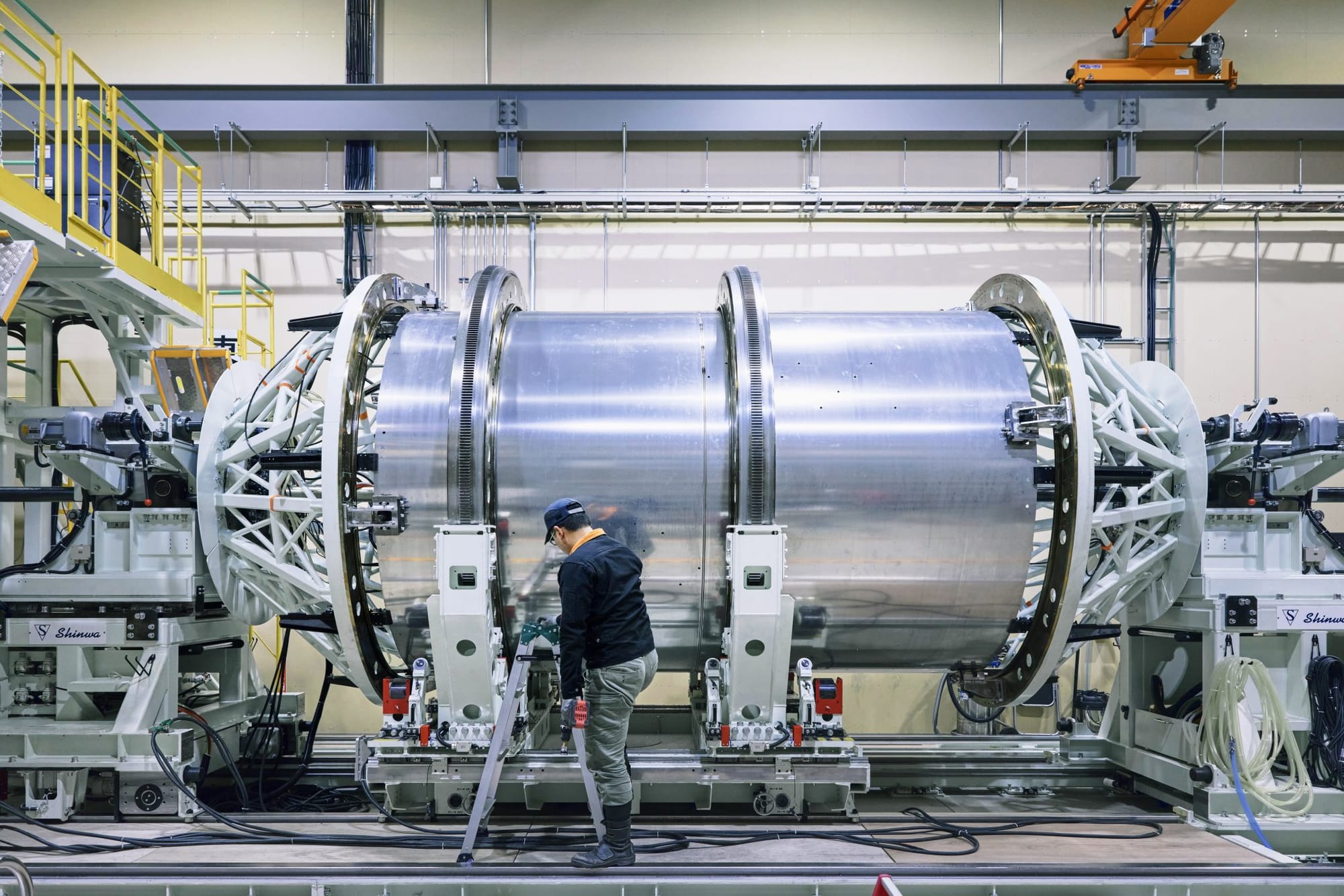
Interstellar propellant tank manufacturing process. Credit: Interstellar -
Interstellar has booked five satellite customers for the inaugural launch of its Zero rocket expected in 2027. The first launch of any new rocket is a high risk event, but if the initial launch is successful, these small satellites will enable Interstellar to quickly establish an initial launch heritage. Zero is the initial rocket being developed by Interstellar, and a follow-on rocket, Deca, will provide greater payload capacity.
-
Axelspace went public on 13 August and closed up 80% at the end of the first day. Axelspace was spun out from Tokyo University in 2008 and has been operating privately since then. It is the fifth space-based IPO over the past few years. The firm already operates five micro-satellites and is aiming to have seven more launched next year with a total of fourteen by May 2028.
-
Sumitomo, the Japanese trading and investment conglomerate, made a strategic investment in Ursa Space Systems, a US satellite imagery analytics firm. The investment will fund expansion into the Japanese and broader Asia market as well as support development of new capabilities. Ursa already has data partnerships with other Japanese firms, including PASCO, iQPS, and Synspective. It’s also not the first such investment in geospatial data analysis capabilities with similar past investments by Mitsui in Spire in 2019 and Itochu in Orbital Insight in 2017.
-
JAXA has posted the 13th Space Exploration Innovation RFP. This research program is over 10 years old and is organized into three funding structures with 12 topics around four themes: next generation energy, next generation mobility, assembly and manufacturing, and habitation. Proposals are due Sept 16, 12p JST. There is a briefing video on YouTube.
🛰️ Technology and Infrastructure
-
iQPS launched its third SAR satellite in as many months [Space.com] on a RocketLab launcher on 11 June from its New Zealand launch complex to a 575km, 42° mid-inclination orbit. RocketLab then launched a fourth SAR satellite [Space.com] on 5 August to a similar 575km orbit. iQPS is continuing to build out a 24-satellite constellation by 2027 and has booked two more launches in 2025 and two in 2026.
-
Honda successfully launched and landed a small reusable rocket from its Hokkaido research center [Nikkei Asia]. The 6.3m, 900kg rocket flew 300m and then landed within 37 cm of its target area. Honda started a space R&D unit in 2019, and it is aiming to build a fully reusable rocket that is capable of launching satellites into orbit.
- Why does this matter? While Honda is not usually associated with space technology, their long-running work on engines, fuel cells, and robotics represents a deep stack of technology that has applications in orbit and on the moon.

Honda’s first reusable test rocket lands successfully in Hokkaido. Credit: Honda
- Why does this matter? While Honda is not usually associated with space technology, their long-running work on engines, fuel cells, and robotics represents a deep stack of technology that has applications in orbit and on the moon.
-
Axelspace successfully launched its GRUS-3α on the 23 June SpaceX Transporter-14 rideshare launch. The microsat successfully reached orbit and Axelspace has made contact. This is a pathfinder vehicle that will precede multiple GRUS-3 satellites planned for 2026.
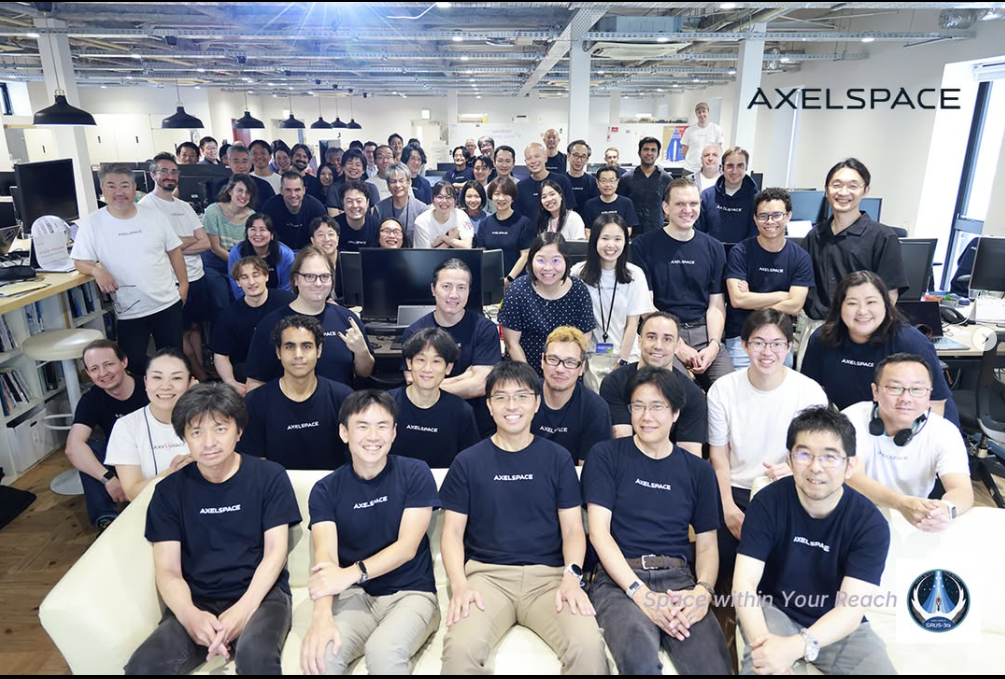
-
Ispace’s initial assessment of the lunar crash of the Hakuto-R lander [SpaceNews] suggests that a failure in the laser range finder led to a delay in the deceleration engine burn and the spacecraft arriving at the surface at high speed. They plan several changes for future landers, including expanding testing of sensors, integrating multiple sensors to provide redundancy, forming a new external review board that will include former engineers from NASA and JAXA, and closer collaboration with JAXA on technical matters. In interview with Nikkei Asia, CEO Hakamada Takeshi, emphasized a number of changes for future missions:
- Payload increases to 500kg in order to make future missions profitable
- Mission 3 will carry a NASA payload under the CLPS program
- Mission 4 will be supported with financial assistance from the METI SBIR program
- Missions 5 and 6 are planned for 2028 with customers to be determined this year
- ispace plans to differentiate itself from other lunar transport providers with technology that enables survival of the two-week lunar night
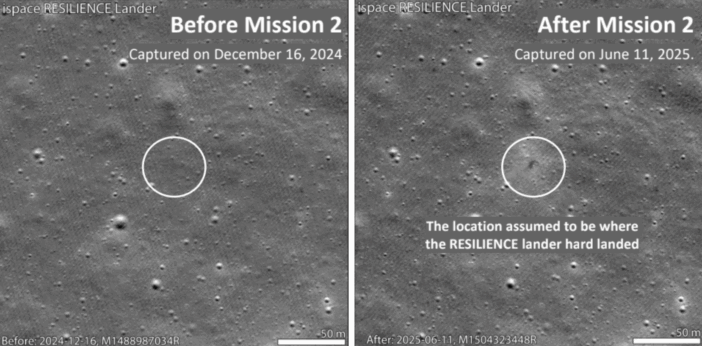
Likely location of RESILIENCE lander’s crash based on NASA’s Lunar Reconnaissance Orbiter (LRO). Credit: NASA/ispace
-
SoftBank expects to be able to fly airships as high altitude platform stations (HAPS) [Nikkei Asia] by 2027. Developed by U.S. firm Sceye, the 65m airships will be able to provide telecom services over 200 km areas during large-scale disasters.
- Why does this matter? Loss of network function was a key challenge in the response to the Noto Peninsula Earthquake in January 2024. NTT Docomo is also pursuing a HAPS initiative with Airbus Aalto subsidiary.
-
Astroscale’s France subsidiary has opened a new headquarters and R&D facility in Toulouse. The France outpost now has more than 30 staff focused on guidance, navigation, and control expertise.
-
JAXA’s 50th and final H-2A rocket lifted off from Tanegashima on 29 June [Space.com] at 1:33am carrying the GOSAT-GW climate observation satellite. The 2.6 ton, 23 meter GOSAT-GW, which now bears the nickname of Ibuki-GW (いぶき-GW), was released into the planned low-Earth orbit of 666 km. The new satellite carries two instruments: TANSO-3 for observing greenhouse gases and AMSR3 for observing the water cycle.
- Why does this matter? The H-2A was a very reliable rocket, only failing once in 50 launches, but it was expensive to build and will now be replaced by the H3 model, which aims to halve the cost and increase the launch cadence.
-
Japanese textile manufacturer, SEIREN (セーレン株式会社), released the first images from the hyperspectral micro-satellite [Nikkei Asia] that it launched in January. The FUSION-1 satellite is only 30 cm long and 10 cm wide but is able to capture hyperspectral images with a 23 cm resolution. The 3U cubesat actually has four cameras jammed into the small spacecraft: a video camera (NanCam), a wide area video camera (WanCam), a medium resolution camera (MRCam) and the hyperspectral instrument (M-HypCam). The satellite was developed in collaboration with Fukui University, Fukui Institute of Technology, and Fukui TV. You can follow the future adventures of the micro-sat at its Twitter/X feed. The satellite is mostly using a Fukui-based ground station, which will limit how much data it can send to the ground.
- *Why does this matter?*This seems like a technology demonstrator, rather than a constellation threat to the Pixxel and Planet Labs Tanager systems. Still, it’s impressive that a 136 year old, mid-sized textile manufacturer is building, launching, and operating a hyperspectral satellite in the name of diversification and regional economic development. That was not on my bingo card for 2025.
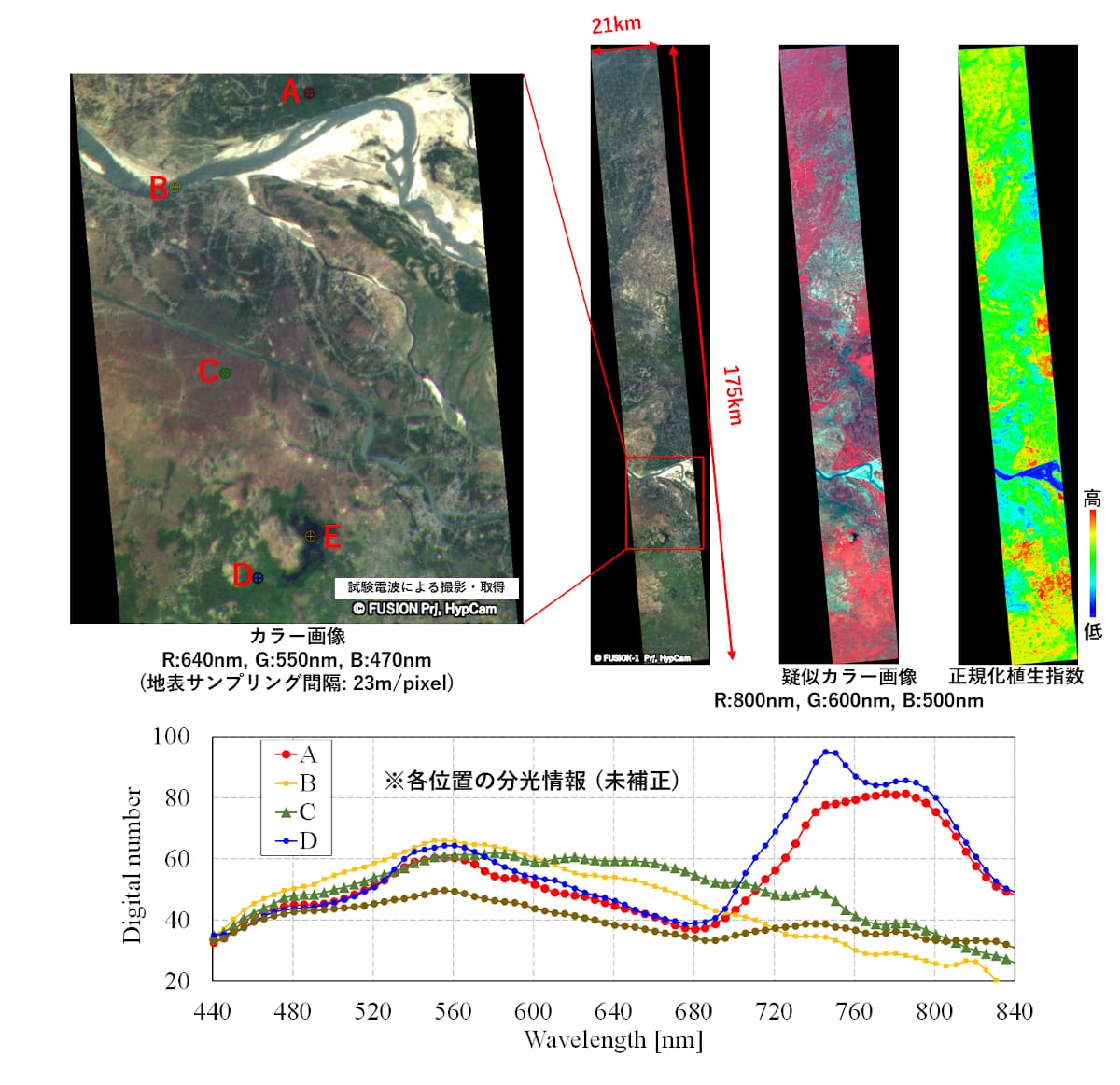
Early imagery output from Seiren’s 3U cubesat’s hyperspectral imager. Credit: Seiren.
- *Why does this matter?*This seems like a technology demonstrator, rather than a constellation threat to the Pixxel and Planet Labs Tanager systems. Still, it’s impressive that a 136 year old, mid-sized textile manufacturer is building, launching, and operating a hyperspectral satellite in the name of diversification and regional economic development. That was not on my bingo card for 2025.
-
The 46th National Model Rocket Challenge was held at the end of May. Sponsored by JAXA and Ministry of Education, Culture, Sports, Science and Technology (MEXT 文部科学省) with funding from Lockheed Martin, this year’s competition attracted almost 200 participants forming 52 teams. Awards were given for both individuals and teams in two categories: parachute descent hang time and streamer descent hang time.
-
A test version of a rocket launched by the Japan subsidiary, jtSpace, of the Taiwan rocket developer, TiSpace, failed to reach its target 100km height [Nikkei Asia]. The VP01 rocket was launched from the Hokkaido Spaceport on 12 July. The first stage operated as expected, but the second stage failed after separation and was terminated.
- Why does this matter? This is the first attempted launch by a non-Japanese spaceflight operator. While it wasn’t successful, it is a demonstration of Japanese spaceport operators’ commitment to attracting an international clientele.
-
Astroscale will use test facilities at the Goddard Space Flight Center (GSFC) [SatNews] to test its Refueler in preparation for two refueling missions planned for the U.S. Space Force. The testing will focus on complex rendezvous and docking maneuvers and is expected to be completed in August 2025.
-
A new variant of JAXA’s H3 rocket successfully completed a first stage static fire test. The “Type 30” variant has 3 LE-9 engines, rather than two, but has no strap-on, solid rocket boosters.
-
The Japan Coast Guard is going to outfit its large patrol ships with SpaceX Starlink terminals [Nikkei Asia]. In JEO 5, I wrote about a similar plan for the Maritime Self-Defense Force (MSDF - what most countries call "the Navy") that will likely put Starlink on MSDF vessels 2024 - 2026. The Coast Guard will have 66 of its large patrol vessels equipped with Starlink in FY2025 and another 16 equipped in FY 2026. The installation process will include the introduction of enhanced encryption capabilities and cybersecurity research.
- Why does this matter? As Japan's Coast Guard faces increasing encounters with Chinese vessels around the Senkaku and other islands in the chain between Japan and Taiwan, the government has been investing in upgrades to the capabilities of its ships and better communications is part of that investment.
-
NYK Line (日本郵船) has passed initial regulatory approval for a sea-based rocket recovery system [Nikkei Asia]. NYK is working with Mitsubishi Heavy Industries on the concept, which will involve two ships operating 1,000km from land: one ship will be the uncrewed landing vessel and the second will be a crewed command vessel. Field testing is currently planned for 2028. Funding to develop the concept will come from the JAXA Space Strategy Fund.

Concept image for NYK Line rocket landing pad. Source: NYK Line
🔭 Science
-
JAXA and ESA X-ray telescope collaboration has identified vast tendrils of super-heated matter [Space.com] stretching between galaxies. The newly discovered intergalactic structures may represent the “missing matter” that physicists have sought to match cosmological models. The research combined data from the JAXA Suzaku observatory (which was deactivated in 2015 after a 10-year observation period) with the ESA XMM-Newton instrument, a particularly long-lived satellite launched in 1999 with a planned 10-year lifespan and has been operating for more than 25 years.
-
University of Tokyo researchers have developed a significant advance in the durability of Sodium-ion batteries [Robotics and Automation News]. This is not, strictly speaking, a geospatial or space item, but battery technology affects energy systems, satellites, spacecraft, drones, and a broad array of contemporary technologies. More sustainable and durable batteries are a big deal.
-
X-ray imaging of samples from the Hayabusa2 asteroid return mission has generated new knowledge about the early conditions of planetary formation in the solar system. Brookhaven National Laboratory performed the analysis on grains from the surface and subsurface of the Ryugu asteroid visited by the Hayabusa2 probe in June 2018 and returned to Earth in December 2020.

X-ray imaging of a grain from Ryugu asteroid showing ancient minerals. Credit: Brookhaven National Laboratory -
Hayabusa2 samples from asteroid Ryugu yielded some additional science in September when a team led by University of Tokyo researcher, Iizuka Tsuyoshi, released the results of isotope analysis suggesting that the main asteroid body from which Ryugu broke off had far more water and for far longer than expected.
- Why does this matter? Because most of the water on Earth is thought to have arrived via asteroid collisions, this may change our understanding about the composition of Earth’s early oceans and atmosphere. Next steps for the research team will be to compare their results against samples returned by the NASA OSIRIS-REs mission from asteroid Bennu.
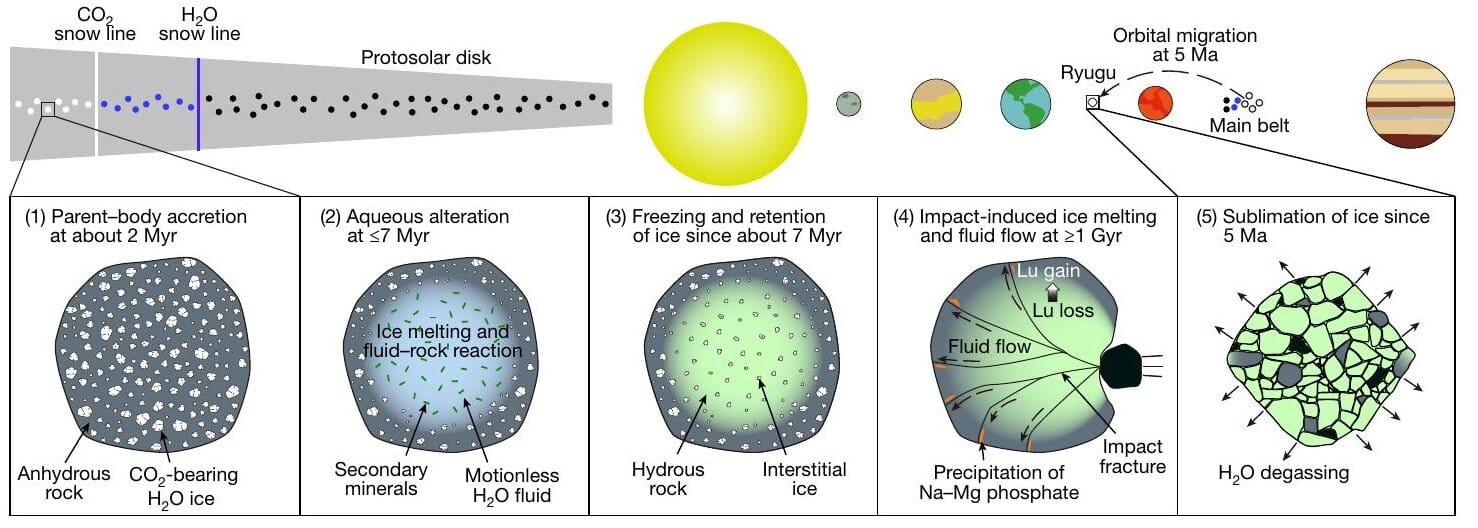
Diagram of how the research team thinks Ryugu evolved over time. Credit: Iizuka, et al, 2025
- Why does this matter? Because most of the water on Earth is thought to have arrived via asteroid collisions, this may change our understanding about the composition of Earth’s early oceans and atmosphere. Next steps for the research team will be to compare their results against samples returned by the NASA OSIRIS-REs mission from asteroid Bennu.
🗺️ International Collaborations
- JAXA and the Philippines Space Agency (PhilSA) have signed an agreement to collaborate on the use of space assets [GMA News] for improving severe weather forecasting and disaster response.
- Japan and the EU will collaborate to build a shared communications satellite constellation in order to reduce reliance on the U.S [Nikkei Asia].
- Why does this matter? The Trump administration's punitive tariffs against long-time allies, combined with Elon Musk’s threat to cut off Ukraine’s access to the Starlink satellite communications service have already had far reaching consequences. Asia Pacific countries are rapidly working to develop trade and defense ties with each other as well as with Europe and Canada in order to reduce the degree to which the U.S. will be able to wield trade and technology as weapons.
- The Australia Space Agency (ASA) is inviting Australian researchers to submit proposals for supporting JAXA’s MMX mission to the Phobos moon of Mars.
- The Japan Cabinet Office (内閣府) is convening a panel of experts in order to develop proposed guidelines and procedures for clearing orbital debris [Japan Today]. The results will be used to lead global discussions on space debris planned for the 2026 meeting of the UN Committee on Peaceful Uses of Outer Space (COPUOS).
- Why does this matter? There is already a lot of debris in orbit and the volume is growing rapidly, particularly in low Earth orbit. Astroscale has emerged as a leader in approach, rendezvous, and servicing of satellites and derelict rocket components, and Japan sees an opportunity to lead in the development of standardized procedures and information sharing. International standards development is an industrial policy playbook that Japan has used successfully in the past. Aerial drone traffic management is a recent example of an ISO standard developed by Hitachi, NTT Data, NEC and NEDO. The core developers of a standard obviously have a leg up implementing hardware and software that will support the standard. Orbital traffic and debris management are ripe for this type of treatment.
- JAXA and ISRO have formalized their plans to collaborate on the Chandrayan-5 lunar mission [The Week] during a visit to Japan by Prime Minister Narendra Modi in August. Also known as LUPEX, the Chadrayan-5 lander will be lofted by a JAXA H3-24L heavy lift configuration. ISRO will build the lander, which will sport sensors from ISRO, NASA, ESA, and JAXA aimed at finding ice in the south pole regions of the moon.
📆 Asia-Pacific Conferences & Events
This newsletter is mostly focused on Japan, but I also like to highlight events across the Asia-Pacific region. Some upcoming conferences in 2025 include:
Oct 2025
- Asia-Pacific International Symposium on Aerospace Technology - 27 - 29 Oct - Seoul, South Korea
- International Congress of Aviation and Space Medicine (ICASM) - 27 - 30 Oct - Singapore
- International Symposium on Antennas and Propagation (ISAP) - 27 - 31 Oct - Fukuoka, Japan
- IEEE International Conference on Space Optical Systems and Applications (ICSOS) 2025 - 28 - 31 Oct - Kyoto, Japan
- Nihonbashi Space Week - 28 - 31 Oct - Nihonbashi, Tokyo, Japan
- 19th Annual Meeting of International Committee on Global Navigation Satellite Systems (ICG) - 19 - 24 Oct - South Korea
Nov 2025
- Asia-Pacific Satellite and Space Community Conference (APSCC) - 4 - 6 Nov - Taipei, Taiwan
- Free and Open Source for Geospatial (FOSS4G) - 17 - 23 Nov - Auckland, New Zealand
- Asia-Pacific Regional Space Agency Forum (APRSAF) - 18 - 21 Nov - Cebu Island, Philippines
- 69th Space Science and Technology Conference (宇宙科学技術連合講演会) - 25 - 28 Nov - Sapporo, Japan
- FOSS4G Shinshu 2025 - 29 - 30 Nov - Shinshu University, Ina, Nagano, Japan
Dec 2025
- International Conference on Space Robotics (iSpaRo) - 1 - 4 Dec - Sendai, Japan
- GeoSmart India - 2 - 4 Dec - New Delhi, India
- State of the Map Japan 2025 - 6 Dec - Osaka University, Osaka, Japan
- Airspace Asia Pacific - 9 - 11 Dec - Hong Kong, China
- IEEE India Geoscience and Remote Sensing Symposium (InGARSS) - 10 - 13 Dec - Bhubaneswar, Odisha, India
- IEEE Communications, Networks, and Satellite (COMNETSAT) - 11 - 13 Dec - Padang, Indonesia
Other recent videos
- Post-launch GOSAT-GW Press Conference- 29 June 2025
- JAXA Space Strategy Fund Year 2 topic briefings
- Solicitation Introduction - 30 May
- Topic: Development of rocket components to increase launch frequency - 30 May
- Topic: Feasibility studies on development and manufacturing of satellite buses and optical communication terminals for satellite optical communication - 30 May
- Topic: Foundational technologies for construction of lunar infrastructure - 30 May
- Topic: Rocket manufacturing processes for high-frequency launches - 23 June
- Topic: Advanced technologies for accelerating the use of Earth environmental satellite data - June 23
- Topic: High-frequency material recovery systems - 23 June
- Topic: Technologies for flexible use of space - 9 July
- Topic: R&D and demonstrations for data relay services using satellite optical communications - 9 July
- Topic: Technologies for efficient extravehicular activity - 9 July
- Topic: Accelerating implementation of satellite data usage - 17 July
- Topic: Development of terminal interconnection technology for optical satellite communications - 17 July
- Topic: Development and demonstration of internationally competitive communications payload technologies - 17 July
- Topic: Orbital data center construction technology - 31 July
- Topic: High-precision landing technologies for lunar polar regions - 31 July
- Topic: Feasibility studies on launch site facilities upgrades contributing to high-frequency launches - 31 July
- Topic: Foundational technologies for ensuring safety in crewed space transportation systems - 19 Aug
- Topic: Innovative satellite mission technology demonstration support - 19 Aug
- Topic: Technologies for enhancing capabilities of next-generation Earth observation satellites - 19 Aug
- Topic: Technologies for enhancing spacecraft mobility - 19 Aug
- Topic: SX Center for Research and Engineering (SX-CRANE) - a research center for incubating space spin-offs and new industries - 19 Aug
- Topic: System technology for smart launch sites - 3 Sept
- Topic: Development and demonstration of frequency sharing technologies for integrated operation of satellite and terrestrial networks - 3 Sept
- Topic: Solving environmental testing challenges for spacecraft - 3 Sept
- Topic: SX Core Area Development Research "SX-ARK" - 24 Sept
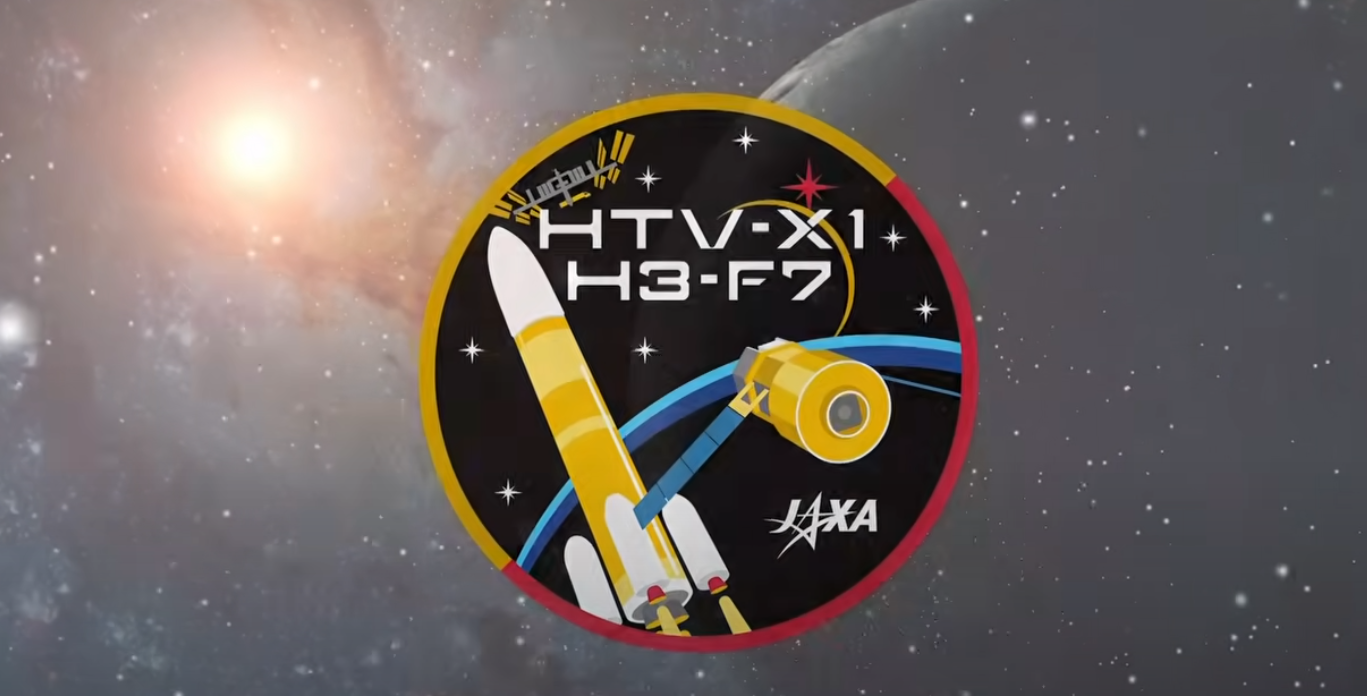
The HTV-X Cargo Freighter and the LEO Supply Chain
The ISS will celebrate its 25th anniversary in November this year. That’s twenty-five years of sustained human presence in low Earth orbit. For a generation of young Earthlings, there has never been a time when humans have not been living in orbit. That is not just a milestone in its own right, the ISS has been an underappreciated example of international cooperation (except for the part about the U.S. Congress passing a law banning Chinese taikonauts from visiting) with Russian, ESA, NASA, Japanese and other astronauts living and working together, even after Russia’s invasion of Ukraine. And those astronauts have not been hanging out up there. In addition to the hard work of just living in microgravity (astronauts are supposed to do at least 2.5 hours a day of exercise), they are building, maintaining, and enhancing the structure as well as doing a lot of science. With more than 4,400 scientific papers published through 2025, it sits alongside the CERN’s Large Hadron Collider as one of the most successful scientific collaborations in human history.
The ISS construction effort was a collaborative venture. The United States, Europe, Japan, and Russia all contributed modules and components to the structure with 90% being carried up by the 36 flights of the Space Shuttle. However, while major construction was completed in 2009, it is not a closed ecosystem. In addition to ferrying people to and from orbit, food, supplies, experiments, and equipment need to be hauled up the gravity well to the ISS’s 400 km orbit. Likewise, garbage, busted or unneeded equipment, and other refuse needs to be sent back down to Earth (there is already a lot of debris in orbit, so shoving the trash out an airlock is not an option). The various ISS partners - ESA, JAXA, NASA, and Russia - have a sort of charming barter system, called the ISS Common System Operations Cost (CSOC) framework, whereby each partner contributes to the overall effort in proportion to the number of astronauts hosted on the ISS. The various contributions often boil down to moving freight and people up and down the gravity well.
When it became clear that the Space Shuttle was not as safe as originally expected and with its retirement in 2011, another solution for crew, cargo, and waste haulage became necessary. In the immediate aftermath of the Shuttle’s retirement, all of the partners relied on Russia’s Soyuz rockets for ferrying people to the ISS. This was seen as a rather awkward situation by NASA, ESA, and JAXA, and significant investment was made to develop alternatives. For moving human crew back and forth, NASA bet on two companies, SpaceX and Boeing. Boeing had a significant head start to build the CST-100 Starliner as well as substantially more experience, but SpaceX developed its Crew Dragon spacecraft far more rapidly and has now launched and returned 11 NASA crews and 4 more private commercial crews. Boeing has only managed to launch one and that one was fraught with technical glitches. Roscosmos (Russia) fly crew to the ISS on the Soyuz spacecraft. ESA and JAXA have not developed a human-rated crew launch capacity.
Cargo was the other priority, and many more cargo missions are required to sustain the ISS. so it requires regular trips. Similar to the construction process, each of the partners has contributed cargo missions:
- NASA cargo flights - Similar to a crew transport, NASA bet on three companies for a cargo hauler: SpaceX, Northrop Grumman, and Sierra Space. Again SpaceX was the first to fill the need, and it has since launched 33 cargo missions to the ISS thus far. The second option, Cygnus, was developed by Orbital Sciences, Northrop Grumman, and Thales Alenia for launch on the Antares, Atlas V, and Falcon 9 rockets. A new XL-sized version, Cygnus XL, just had its maiden voyage in September.
- ESA cargo flights - ESA developed the Automated Transfer Vehicle (ATV) for cargo launch contributions and sent five missions atop Ariane 5 rockets from 2008 to 2014. With the retirement of the Ariane 5 and a slow ramp-up of Ariane 6 launches, ESA recently issued an RFP to purchase a cargo transport flight to the ISS. While this ESA RFP is ostensibly a request for proposals, there may only be one response. NASA rules require that these solicitations be open to United States firms, but ESA would much prefer a solution that is made in Europe, and a 5,000 kg cargo requirement will likely narrow the pool significantly. A SpaceX Cargo Dragon can only launch 3,300 kg to the ISS, so two trips would be required to meet ESA's mass requirements. ESA is supporting development of a new pair of LEO cargo spacecraft (Argo and NYX) and Phase 1 efforts are underway. However, both nascent spacecraft are still in early phases and are unlikely to be in production and certified with the necessary cargo capacity for a 2028 launch. So the Cygnus-XL, with 5,000 kg capacity, would seem to be the only viable option. And, lo and behold, the pressurized cargo module of the Cygnus is manufactured by Thales Alenia in Europe, so that will make the ESA members happy.
- Roscosmos cargo flights - Russia’s cargo resupply vessel is the venerable Progress spacecraft and is derived from the Soyuz crewed vehicle The Progress has been through several iterations since its maiden flight in 1978, transporting supplies to Salyut-6, Salyut-7, Mir, and the ISS. The current version, Progress-MS, has been flying since 2015 and has a capacity of 2,230kg. Russia has launched 185 Progress cargo flights since the program’s inception with almost 100 of those flights going to the ISS. Progress vehicles also play a critical role in maintaining the ISS orbit as they can carry extra fuel to boost its orbit in order to counteract ongoing orbital decay.
- JAXA cargo flights - Japan’s cargo contributions have historically been fulfilled with the H-II Transfer Vehicle (HTV), also known as Kounotori (こうのとり). The HTV flew atop the H-IIB rocket nine times from 2009 to 2020. This cargo spacecraft has played a critical role supplying the ISS, particularly after the Space Shuttle’s retirement, when it became the only cargo vehicle that could carry and transfer International Standard Payload Rack (ISPR), a standardized, metal-framed container for transporting machinery and experiments to the ISS. With the H-IIB rocket’s planned retirement and its replacement by the H3, in 2015 JAXA began developing a new cargo vehicle: the HTV-X. Formally known as the New Space Station Resupply Vehicle (新型宇宙ステーション補給機), the HTV-X has been redesigned to not only use the newer H3 rocket but to increase the cargo capacity by 50% to 6 tons.

Various cargo spacecraft designs with pressured cargo (red), fuel (blue), and unpressurized cargo modules. Credit: Wikimedia Commons (user: Craigboy) - CC BY-SA 3.0
What is the HTV-X and why was it necessary?
Japan already had a successful, flight-tested cargo vehicle, so why would it need a new one? There is usually a tight integration between a rocket launch vehicle and the cargo it can carry on top. With the retirement of JAXA’s H-IIB rocket and the introduction of H3, the rocket would have new engines, new dimensions, and new capabilities, and at a minimum, it would be necessary to adapt the HTV if not completely rework the design. JAXA elected to do the latter. The overall HTV-X development team was similar to the HTV and included Mitsubishi Heavy Industries (pressurized module and rocket integration), Mitsubishi Electric (service module), IHI Aerospace (propulsion systems), and American firm, Sierra Nevada (Common Berthing Mechanism and hatch kit).
The HTV-X design included a number of key objectives:
- Increase both weight and volume of cargo capacity
- Increase electricity generation capacity proportionally
- Reduce cost (this objective is shared with the H3 rocket as well)
- Enable late access to the pressurized cargo space in order to support last-minute additions of perishable food or experiment contents
- Support additional technology experiments after unberthing from the ISS
- Anticipate future needs for the Lunar Gateway and commercial space stations
While I cannot really assess the cost reduction goal, at a technical level the HTV-X has delivered on all of the other objectives. Combining a pressurized (4,070 kg) cargo module and an “exposed” or unpressured module (1,750 kg) the total payload capacity is 5,820 kg, approximately a 50% increase over HTV as well as a 60% cargo volume capacity. WIth larger and more efficient solar panels, the electricity generation capacity was also increased by 50%. Other than Cygnus, none of the cargo spacecraft to the ISS are able to generate their own electricity so they have to run on batteries while they are in transit to the ISS. HTV-X can generate 1 kW of power with two large solar panels that are extended after separation from its boosters. While the spacecraft also carries 3 kW of batteries, the ability to generate electricity enables it to carry more cargo that needs to maintain consistent temperature or has other power requirements. The solar panels will also enable it to carry out the follow-on experiments after it is unberthed from the ISS.
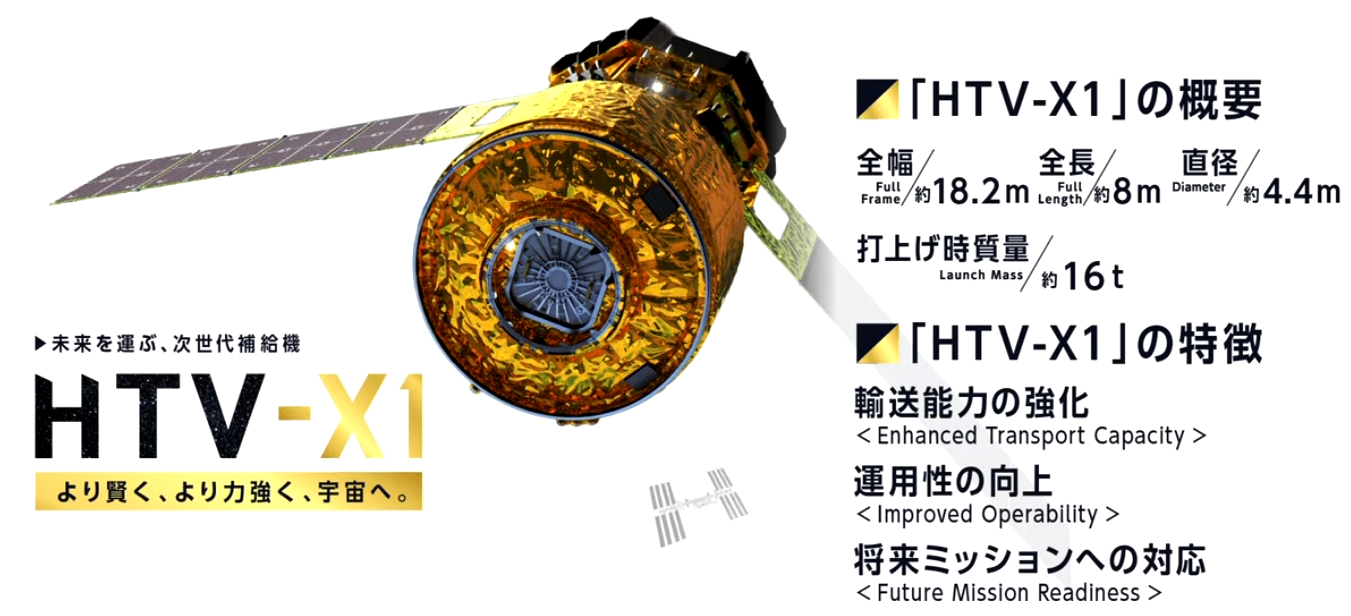
HTV-X1 concept image. Credit: JAXA
Mitsubishi Heavy Industries and Mitsubishi Electric are the primary system integrators but the supply chain is extensive. JAXA has highlighted a few of them in a press conference during the summer [YouTube] and the following table summarizes the key firms involved:
Pressurized Module (与圧モジュール)
| Role/Component | Company |
|---|---|
| Primary integrator | Mitsubishi Heavy Industries (三菱重工業) |
| Controls Devices (制御装置) | Mitsubishi Precision (三菱プレシジョン) |
| Machining of the main structure (主構造の機械加工) | Hikari Manufacturing (光製作所) |
| Soundproofing (防音装置) | Sasakura AE (ササクラ・エーイー) |
| Cargo loading racks (カーゴ搭載ラック) | IHI Aerospace (IHIエアロスペース) |
| Air ducting (空調ダクト) | Yasojima Proceed (八十島プロシード) |
| Communications processing controls (通信変換処理装置) | AES (エー・イー・エス) |
| Operations preparation (運用準備) | Space Engineering Development (宇宙技術開発) |
Service Module and Exposed Cargo (サービスモジュールと曝露カーゴ
| Role/Component | Company |
|---|---|
| Primary integrator | Mitsubishi Electric (三菱電気) |
| Propulsion, structure, exposed cargo, mounting component (推進系・構造系・曝露カーゴー・搭載部) |
IHI Aerospace (IHIエアロスペース) |
| Software & operational control system (運用管制システム) | Mitsubishi Electric Software (三菱電気ソフトウェア) |
| Battery Module and Cells (電池モジュール/セル) | Mitsubishi Electric/GS Yuasa Technology (三菱電気/GSユアサ) |
| Structure (hexagonal structure) (構体) | Nippon Aircraft/Daiki Industries (日本飛行機・大起産業) |
| Control devices and power supply (制御装置・電源機器) | Mitsubishi Electric Defense & Space Technologies (三菱電気ティフェンス&スペース・テクノロジーズ) |
| Relative Navigation Sensor (相対航法センサー) | Nippon Electric (日本電気) |
| Monitor Camera (モニターカメラ) | MEISEI Electric (明星電気) |
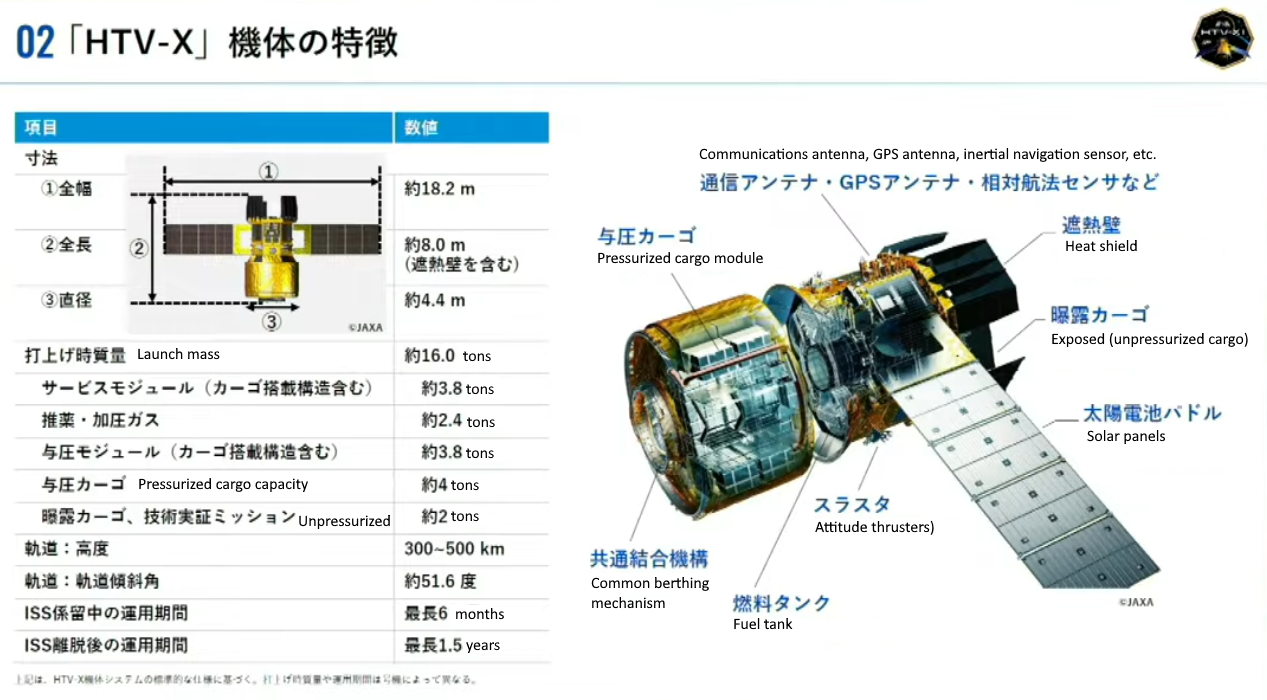
HTV-X specs, modules and components. Credit: JAXA
The Inaugural HTV-X1 Mission - All kinds of Firsts
The HTV-X1 that launched on 26 October (Japan time) had a number of firsts. In addition to being the first launch of the HTV-X spacecraft, this 7th launch of the H3 rocket was the first H3 in the H3-24W configuration, which both adds 4 solid rocket boosters to increase lift capacity and uses a wide payload fairing to accommodate the larger HTV-X. The wide payload fairing is made from a different material from the usual one and instead of opening as a clamshell, it has to pop away in parallel from the rocket body. This alternative fairing material also doesn’t sink, so JAXA had a ship standing by to recover the two pieces.
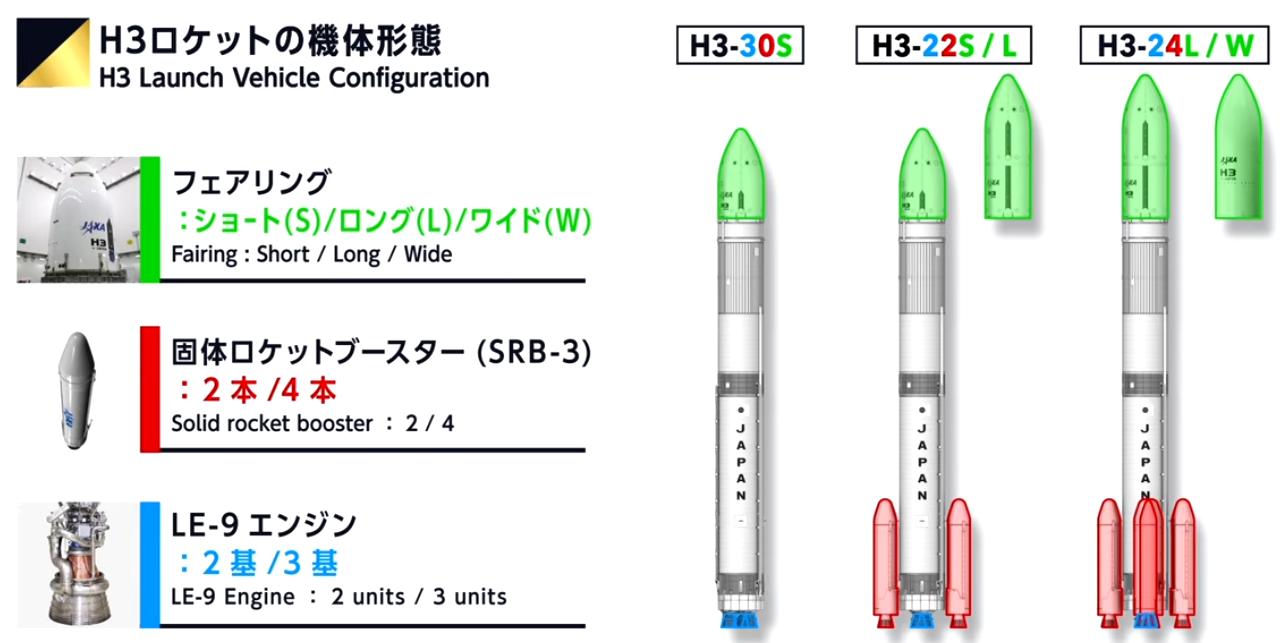
Diagram of the three H3 configurations based on number of engines, solid rocket boosters, and fairing size. Credit: JAXA
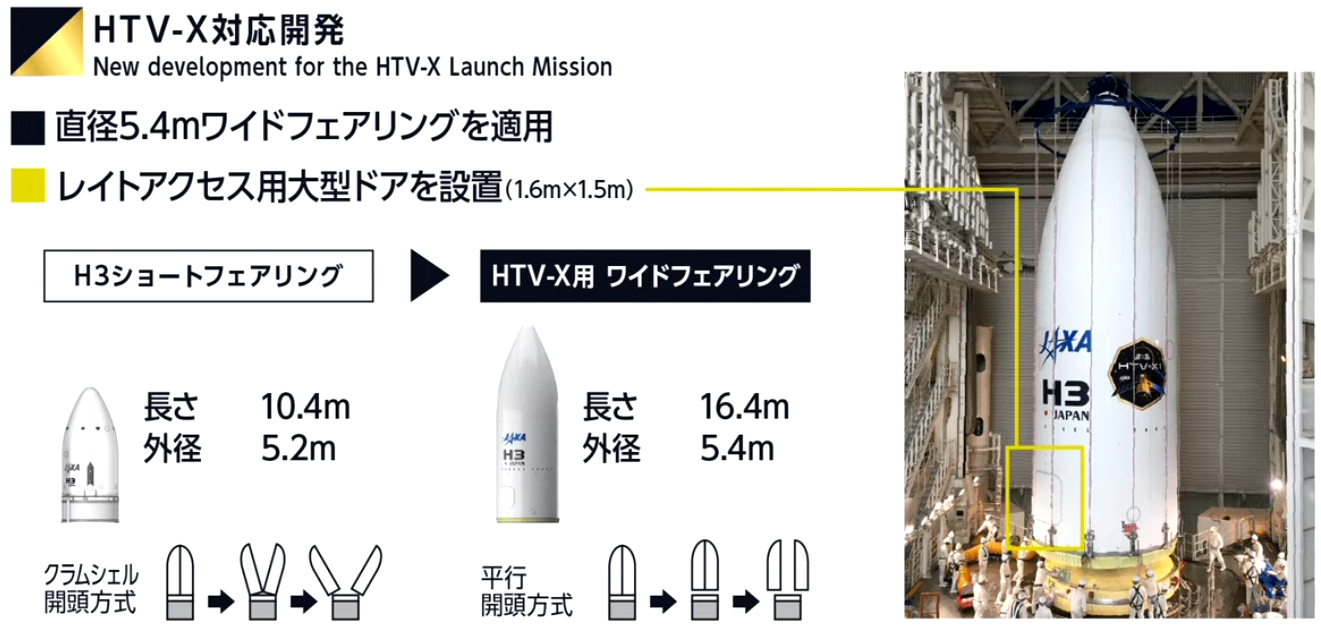
Size comparison between the usual H3 short fairing and the HTV-X wide/long fairing. Credit: JAXA
In addition to the hardware, this launch will be the first test of an autonomous flight safety system (自律飛行安全システム), an onboard software control system that will enable the rocket to continue flying on its own through second stage engine cutoff if communications with the ground is lost. This flight did not actually use the system, so data was collected to assess its effectiveness.
This flight will also be the first test of JAXA’s implementation of support for NASA’s Tracking and Data Relay Satellite (TDRS) System. The TDRS communications infrastructure extends the tracking and relay system from relying solely on ground stations by adding a constellation of data relay satellites in geosynchronous Earth orbit. The goal of TDRS is to increase the time that spacecraft are in communications with the ground and the amount of data that can be transferred. The TDRS is used extensively by NASA and the U.S. military for a range of systems, including the Hubble Space Telescope and Landsat satellites. JAXA has not used the TRDS in the past but with the MMX mission to Mars and future lunar missions, they anticipate needing this additional tracking and data capacity. However, while TDRS is actively used, NASA considers it a legacy system and is seeking to transition these functions to commercial communications satellites in the future. It is also worth noting that ESA (EDRS), Russia (Luch, Altair, or Gelios), and China (Tianlian, 天鏈, or SkyLink) all operate their own data relay satellite constellations, and India is planning one as well (IDRSS). Since HTV-X will burn up when it is returned to Earth, JAXA is not making a long-term bet on NASA’s TDRS system, and this experiment will doubtless provide JAXA with operational experience using this type of system.

Illustration of the TDRS tracking and data relay system. Credit: JAXA
The final first relates to a major design change in HTV-X over its predecessor and it also represents a significant difference from every other ISS cargo vehicle. HTV-X can remain docked at the ISS for up to 6 months, but while other cargo vessels are sent back to Earth after they undock from the ISS (and most burn up in the atmosphere or fall into the Pacific Ocean), HTV-X is capable of follow-on missions. On this test flight, after collecting the ISS rubbish, JAXA will send HTV-X1 to a higher 500km orbit in order to carry out a series of additional experiments:
- First, about a week after separation from the ISS, it will launch a cubesat from an onboard launcher, the H-SSOD (超小型衛星放出), built into the Service Module.
- A couple of weeks after that, it will launch and test Mt.FUJI (軌道上姿勢運動推定実験), an orbital space debris observation and measurement experiment that will use a ground-based laser to assess the attitude of debris in an uncontrolled tumble.
- About two months after unberthing from the ISS, HTV-X1 will test the DEployable LIGHtweight planar antenna Technology demonstration (DELIGHT) (展開型軽量平面アンテナ軌道上実証システム) [JAXA], an ultra-lightweight antenna (only 4.7e g) that can fold into a flat pack for launch and then unfold into a much larger antenna in orbit.
- Finally, HTV-X1 will deploy an experiment aimed at testing techniques for assembling and connecting advanced solar panels (太陽電池実証試験)
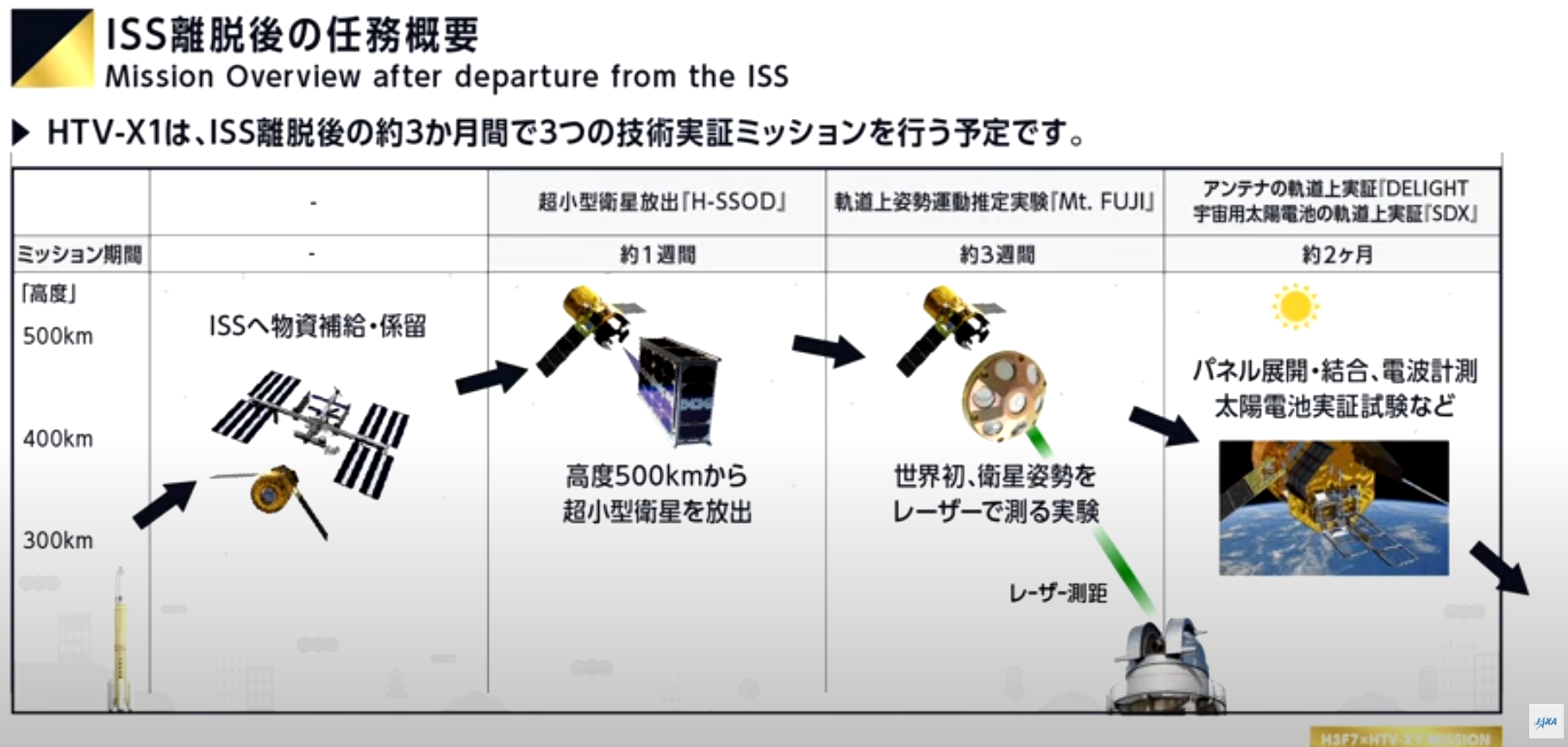
Overview of three follow-on missions for HTV-X after leaving the ISS. Credit: JAXA
In addition to the post-ISS technology tests, the cargo manifest on HTV-X1 is pretty extensive and includes:
- Crew supplies
- Kibō (JAXA-operated research module on the ISS) system components
- Demonstration system for carbon dioxide removal (DRCS)
- Nitrogen/Oxygen recharge system (NORS)
- Water resupply tank (RST)
- Science and technology experiments
- Lab automation tools for Kibō
- Experiments proposed by students from Asia-Pacific region
- A bunch of cubesats from deployment from Kibo
- Private sector research projects under JAXA’s fee-based Kibō commercial utilization program - these range from marketing initiatives to rice seedlings and an attempt to brew sake in orbit by Dassai
The HTV-X does not have an automatic docking mechanism. Rather, it will approach the ISS and match its orbit. When it closes the distance to about 10 meters, a JAXA astronaut will use the Canadarm2 to reach out, grasp the cargo ship, and then pull it into a berth on the Harmony module.

A view of the Canadarm grasping the HTV-6 cargo ship. Credit: NASA
Coordination of ISS Crews and Cargo
As I’ve been writing this overview of the JAXA cargo spacecraft, I started wondering how all of the various spacecraft visits and cargo manifests are coordinated. I mean, there’s already a pile full of visiting vehicles parked at the ISS, and JAXA can’t just fly an HTV-X up there, knock on the hatch and say “Hey, we’re here, and we brought a bunch of stuff.” As you might expect, it turns out there is a system. NASA, Roscosmos (Russia), ESA (Europe), and JAXA (Japan), and other station partners collaborate on both scheduling missions and determining their cargo manifests.

Vehicles currently visiting the ISS as of 25 Oct 2025. Credit: NASA
Interagency Coordination and Scheduling
Cargo resupply schedules are developed via the ISS Multilateral Coordination Board (MCB) and Integrated Planning and Operations Teams. These groups meet regularly to set annual and 6-month mission plans, align resupply needs, and allocate launch opportunities among the partners. Each agency proposes its launches, and these are then integrated into a joint traffic plan to avoid scheduling conflicts, optimize docking usage, and ensure steady logistics coverage for ISS operations.
Manifest Planning for Cargo Contents
The contents of each cargo flight are determined through a two-phase process:
- Phase 1 - Strategic Planning: At least a year out, partners submit their utilization objectives, experiment needs, crew supply forecasts, and maintenance items. The partners then negotiate, prioritizing mission-critical supplies, international commitments, and research payloads. This feeds into a provisional top-level manifest.
- Phase 2 - Execution Planning: As launch approaches, the manifest becomes more detailed, reflecting changes due to hardware readiness, experiment timelines, and unexpected needs. Integration teams - including NASA, ESA, JAXA, Roscosmos, and relevant contractors - finalize the packing lists, hardware stowage, and upload logistics, often until just days before launch. Manifest changes require approval through joint review boards and are coordinated to maintain fairness and fulfill all participating agencies' obligations.
Agency-specific Roles and Cooperation
Each agency has primary responsibility for its own cargo vehicle and associated ground operations. For joint missions, contractors and integration specialists from all involved parties work together during cargo loading and checkout - for example, NASA and ESA for ATV, or NASA and JAXA for HTV-X flights. NASA, as the ISS lead operator, maintains oversight of overall resource allocation and verifies that visiting vehicles and their contents meet station interface and safety standards via formal readiness and integration reviews. Finally, real-time adjustments to manifests can be made to respond to contingency needs, like hardware failures or urgent medical supplies.
But can it do the Kessel Run in less than 12 parsecs?
None of the ISS cargo freighters described above will ever be as fast as the Millenium Falcon, but human space exploration requires regular resupplies, and we have collectively developed a few cargo freighters to get the job done. A thriving space economy in near Earth orbit is going to require an increasing number of these types of spacecraft, and JAXA’s HTV-X is positioned to not only supply the ISS until its demise 2030 but also a likely future in which there are multiple commercial space stations as well as other more distance human outposts, like the Lunar Gateway.
To that end JAXA is taking steps to develop two new variants of the HTV-X, one for supply trips to the planned Lunar Gateway and one for commercial space stations.
HTV-XG (月探査補給機): The Trump administration’s proposed NASA budget would have cut Gateway and reduced the number of SLS launches. However, the U.S. Congress seems committed to the space exploration program, and the current budget under discussion maintains funding for Artemis and the Lunar Gateway Space Station. While that budget has not yet been approved, continuation of the Artemis and Gateway programs will likely come as a relief to partner space agencies as a raft of work on Gateway modules has already been completed and are moving toward launch in the 2027 - 2029 timeframe.
Like the ISS, Gateway is being constructed as an international collaboration that currently includes NASA, ESA, JAXA, Canada, and the United Arab Emirates. (Russia and Roscosmos has been kicked to the curb and are joining China’s lunar endeavors.) The construction of Gateway will begin with two modules being built under contract for NASA - the Power and Propulsion Element (PPE) and Habitation and Logistics Outpost (HALO) - that will be launched together on a single Falcon Heavy rocket. Next, the European System Providing Refueling, Infrastructure and Telecommunications (ESPRIT) service module will provide additional propulsion fuel capacity, more communications equipment, and an airlock for science packages. UAE is building a Crew and Science Airlock Module that will be used for extravehicular activities and other docking needs. ESA and JAXA are working together to build the Lunar International Habitation Module (Lunar I-HAB). JAXA is responsible for supplying the life support system, environmental controls, batteries, thermal control, and imagery components on the I-HAB. Finally, Canada is building a pair of arms (Canada seems to have a monopoly in the space arm marketplace), called Canadarm3. JAXA has also committed to providing a resupply vehicle, HTV-XG, which will be a modified version of HTV-X. Mitsubishi Heavy Industries is leading this effort and has outlined a couple of key changes [Japanese] that will be necessary. First, the pressurized cargo power supply will need to generate 10 times more power than HTV-X while maintaining cargo volume. This will require a significant weight reduction and MHI plans to accomplish this by replacing metal components with composite materials. This will also necessitate an ability to shed more heat by integrating a radiator. Second, because the Gateway will not always have a crew that can use the robotic arm to pull the ship into dock, HTV-X will need to have an autonomous docking capability. There are four more HTV-X trips planned to the ISS, and JAXA and MHI will likely begin incrementally integrating and testing these new features as part of these missions.
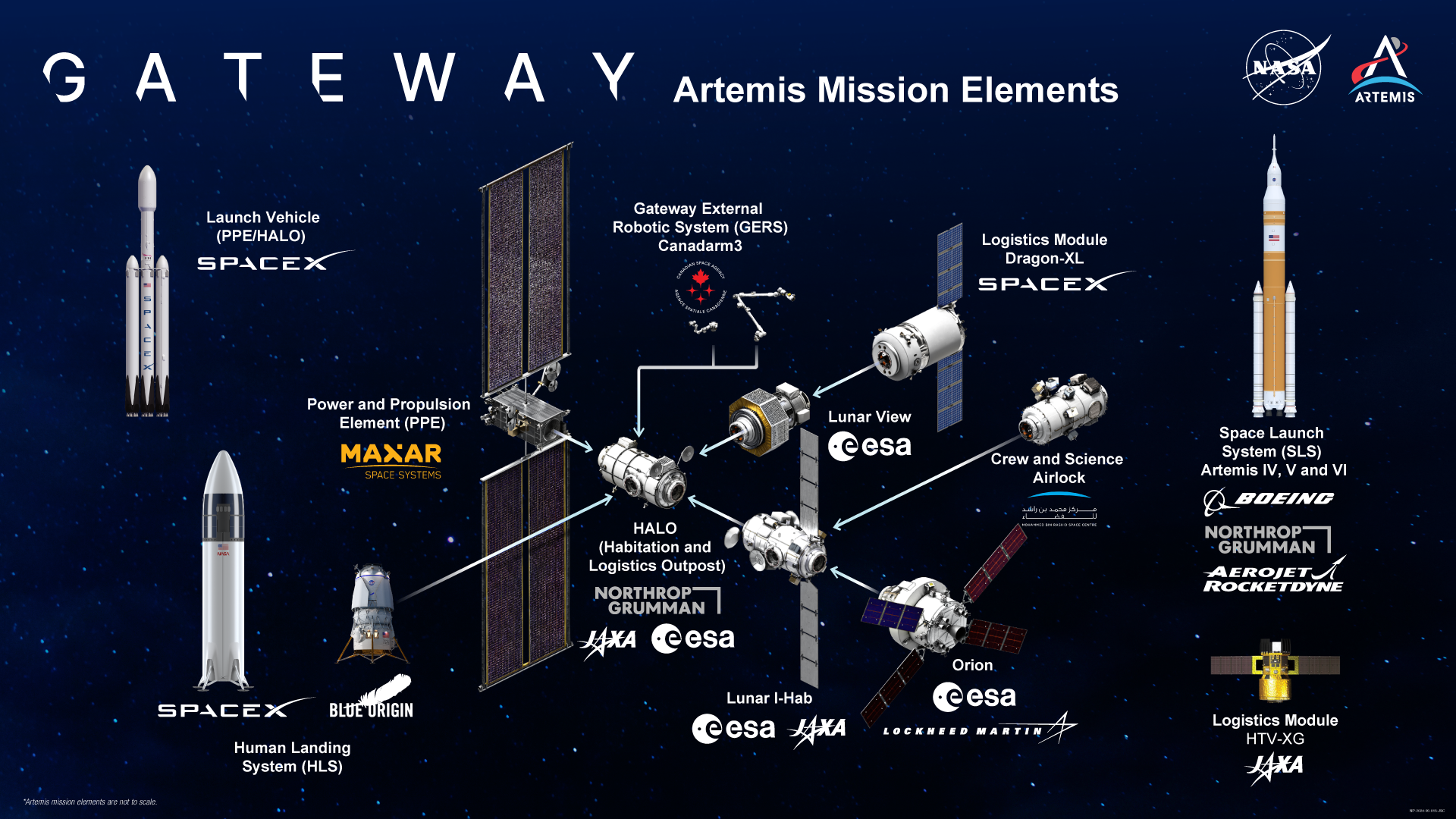
Gateway and Artemis mission elements. Credit: NASA
HTV-XC (商用物資補給船): The next generation of low Earth orbit space stations will be led by the private sector, and there are now several commercial space station efforts under development, including Starlab, Axiom Space, Blue Origin/Sierra Space, and Vast. It is not clear that they will all make it to orbit, so Japan is placing bets on all of them. Japanese trading companies have investor stakes in Starlab, Axiom Space, and Blue Origin/Sierra Space Orbital Reef project. Japan Manned Space Systems (JAMSS) is developing a multi-purpose payload component for the Vast HAVEN-1 that can accommodate microgravity experiments and small payload modules. JAXA is also investing in development of of a commercial version of the HTV-X (HTV-XC) that can launch resupply missions to any commercial space and in development of a space station module that can operate either autonomously as a standalone station or while docked with one of the commercial space stations. Design and technology development work for both initiatives has been awarded by JAXA to Japan LEO Shachu (日本低軌道社中), a 2024 spinoff from Mitsui & Co (三井物産), using funding from the JAXA Space Strategy Fund beginning in July 2025. Mitsui & Co. has been operating the cubesat deployment service attached to the Kibō module on the ISS, so they have some insights into what will be required for a new research and experimentation module. The Kibō module has been one of the most successful initiatives in the history of the Japanese space program, and it naturally wants to sustain this leadership in the next chapter of LEO exploration. A science and research module that can dock with any of the commercial space stations as well as operate autonomously will set up Japan to both maintain an independent LEO presence and set the stage for its own space station in the future. The upgraded reapply ship will need to incorporate new technology for flexible near-field communications and navigation functions, support docking at multiple commercial space stations, and autonomous docking technology that is flexible, safe, and reliable.
If you’ve made it this far, thank you for reading. Please be in touch via LinkedIn with any feedback, questions, comments, or requests for future topics. And if you have a friend or colleague that you think would enjoy JEO, please feel free to share it!
Until next time,
Robert
As I walk away
it opens wide
the harvested field.
– Uejima Onitsura (1661–1738)
去るほどに
うちひらきたる
刈田かな
saru hodo ni
uchi hirakitaru
karita kana